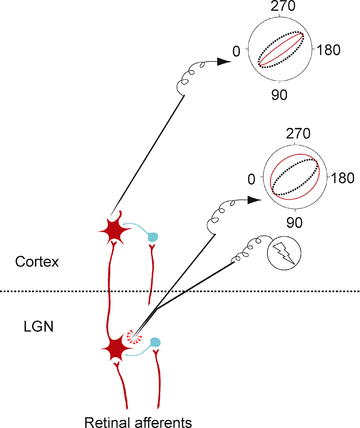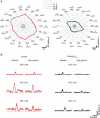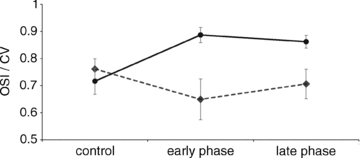Role of feedforward geniculate inputs in the generation of orientation selectivity in the cat's primary visual cortex
- PMID: 21486788
- PMCID: PMC3098707
- DOI: 10.1113/jphysiol.2010.202317
Role of feedforward geniculate inputs in the generation of orientation selectivity in the cat's primary visual cortex
Abstract
Neurones of the mammalian primary visual cortex have the remarkable property of being selective for the orientation of visual contours. It has been controversial whether the selectivity arises from intracortical mechanisms, from the pattern of afferent connectivity from lateral geniculate nucleus (LGN) to cortical cells or from the sharpening of a bias that is already present in the responses of many geniculate cells. To investigate this, we employed a variation of an electrical stimulation protocol in the LGN that has been claimed to suppress intra cortical inputs and isolate the raw geniculocortical input to a striate cortical cell. Such stimulation led to a sharpening of the orientation sensitivity of geniculate cells themselves and some broadening of cortical orientation selectivity. These findings are consistent with the idea that non-specific inhibition of the signals from LGN cells which exhibit an orientation bias can generate the sharp orientation selectivity of primary visual cortical cells. This obviates the need for an excitatory convergence from geniculate cells whose receptive fields are arranged along a row in visual space as in the classical model and provides a framework for orientation sensitivity originating in the retina and getting sharpened through inhibition at higher levels of the visual pathway.
Figures






Similar articles
-
Emergence of orientation selectivity in the Mammalian visual pathway.J Neurosci. 2013 Jun 26;33(26):10616-24. doi: 10.1523/JNEUROSCI.0404-13.2013. J Neurosci. 2013. PMID: 23804085 Free PMC article.
-
Orientation tuning of surround suppression in lateral geniculate nucleus and primary visual cortex of cat.Neuroscience. 2007 Nov 23;149(4):962-75. doi: 10.1016/j.neuroscience.2007.08.001. Epub 2007 Aug 9. Neuroscience. 2007. PMID: 17945429
-
Relation of cortical cell orientation selectivity to alignment of receptive fields of the geniculocortical afferents that arborize within a single orientation column in ferret visual cortex.J Neurosci. 1991 May;11(5):1347-58. doi: 10.1523/JNEUROSCI.11-05-01347.1991. J Neurosci. 1991. PMID: 2027051 Free PMC article.
-
Origins of feature selectivities and maps in the mammalian primary visual cortex.Trends Neurosci. 2015 Aug;38(8):475-85. doi: 10.1016/j.tins.2015.06.003. Epub 2015 Jul 22. Trends Neurosci. 2015. PMID: 26209463 Review.
-
The dynamics of visual responses in the primary visual cortex.Prog Brain Res. 2007;165:21-32. doi: 10.1016/S0079-6123(06)65003-6. Prog Brain Res. 2007. PMID: 17925238 Review.
Cited by
-
Emergence of orientation selectivity in the Mammalian visual pathway.J Neurosci. 2013 Jun 26;33(26):10616-24. doi: 10.1523/JNEUROSCI.0404-13.2013. J Neurosci. 2013. PMID: 23804085 Free PMC article.
-
An Integrated Neuronal Model of Claustral Function in Timing the Synchrony Between Cortical Areas.Front Neural Circuits. 2019 Feb 5;13:3. doi: 10.3389/fncir.2019.00003. eCollection 2019. Front Neural Circuits. 2019. PMID: 30804759 Free PMC article.
-
A computational study of how orientation bias in the lateral geniculate nucleus can give rise to orientation selectivity in primary visual cortex.Front Syst Neurosci. 2011 Oct 11;5:81. doi: 10.3389/fnsys.2011.00081. eCollection 2011. Front Syst Neurosci. 2011. PMID: 22013414 Free PMC article.
-
A new angle on the role of feedfoward inputs in the generation of orientation selectivity in primary visual cortex.J Physiol. 2011 Jun 15;589(Pt 12):2921-2. doi: 10.1113/jphysiol.2011.209031. J Physiol. 2011. PMID: 21676883 Free PMC article. No abstract available.
-
Subcortical orientation biases explain orientation selectivity of visual cortical cells.Physiol Rep. 2015 Apr;3(4):e12374. doi: 10.14814/phy2.12374. Physiol Rep. 2015. PMID: 25855249 Free PMC article.
References
-
- Bloomfield SA, Sherman SM. Postsynaptic potentials recorded in neurons of the cat's lateral geniculate nucleus following electrical stimulation of the optic chiasm. J Neurophysiol. 1988;60:1924–1945. - PubMed
-
- Bullier J, Mustari MJ, Henry GH. Receptive-field transformations between LGN neurons and S-cells of cat striate cortex. J Neurophysiol. 1982;47:417–438. - PubMed
-
- Carandini M. Melting the iceberg: contrast invariance in visual cortex. Neuron. 2007;54:11–13. - PubMed
Publication types
MeSH terms
LinkOut - more resources
Full Text Sources
Miscellaneous

